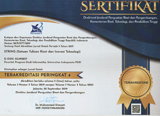Optimalisasi Waktu Kerja Karyawan Menggunakan Metode Hungarian (Studi Kasus CV Bintang Jaya)
(1) Universitas Singaperbangsa Karawang
(2) Universitas Singaperbangsa Karawang
(3) Universitas Singaperbangsa Karawang
(*) Corresponding Author
Abstract
The most common problem in business and industry today is the optimal allocation of production resources, i.e. providing different levels of productivity in different tasks. The challenge of CV Bintang Jaya is how to optimize working hours according to the working hours of its employees. The purpose of this study is to determine the working time of employees in accordance with the work. The research method used is hungarian using the POM-QM application for Windows. Data are collected through observation, interviews, documentation and literature study. From this study, the best results are obtained based on the work. Employee 1 takes 17 minutes to perform the wood cutting operation, employee 2 takes 35 minutes to make a pattern, employee 3 takes 10 minutes to perform the smoothing operation, and employee 4 takes 10 minutes to perform the assembly operation.
Keywords
Full Text:
PDFReferences
S. Basriati and A. Lestari, “Penyelesaian Masalah Penugasan Menggunakan Metode Hungarian dan Pinalti (Studi Kasus: CV Surya Pelangi),” J. Sains Mat. dan Stat., vol. 3, no. 1, pp. 75–81, 2017.
L. N. Rahman and W. Wahyudin, “Optimalisasi Penugasan Karyawan Jasa Ekspedisi Menggunakan Metode Hungarian (Studi Kasus CV Anteraja Cabang Mekarmukti),” J. Serambi Eng., vol. 6, no. 3, Jul. 2021, doi: 10.32672/jse.v6i3.3245.
D. Maulina and M. R. Jatnika, “Kombinasi Metode Hungarian dan Permutasi untuk Pendukung Keputusan Penugasan Departemen dan Koordinator Divisi,” J. Mantik, vol. 3, no. 1, pp. 160–167, 2019.
I. G. So, H. Sarjono, and R. T. Herman, “Penerapan Metode Hungarian pada Perusahaan Jasa (Kasus Minimum),” Binus Bus. Rev., vol. 4, no. 2, pp. 812–820, Nov. 2013, doi: 10.21512/bbr.v4i2.1397.
H. Herlawati, “Algoritma Hungarian Dalam Menentukan Pembagian Tugas Sebagai Manajemen Jurnal Pada Open Journal System (OJS),” Inf. Syst. Educ. Prof. J. Inf. Syst., vol. 2, no. 1, pp. 83–94, 2017.
S. Aji, K. Soemadi, and F. H. Mustofa, “Optimisasi Keuntungan Menggunakan Linear Programming di PT Pertamina Refinery Unit (RU) VI Balongan,” Reka Integr., vol. 1, no. 3, pp. 232–242, 2013.
A. Widodo, M. Makhsun, and A. Hindasyah, “Analisis Pengendalian Persediaan Bahan Baku PVC Compound Menggunakan Metode ABC Analisis dan EOQ Berbasis POM-QM for Windows V5.2,” J. Inform. Univ. Pamulang, vol. 5, no. 2, pp. 188–197, Jun. 2020, doi: 10.32493/informatika.v5i2.5449.
I. Nuryana, “Optimasi jumlah produksi pada UMKM Raina Kersen dengan metode Linear Programming,” Ilham Nuryana, vol. 6, no. 1, pp. 67–90, 2019.
L. Liana, “Pencapaian Biaya Minimum Menggunakan Metode Hungarian dan Daftar Kombinasi,” JBE (Jurnal Bingkai Ekon., vol. 2, no. 2, pp. 36–47, 2017.
K. M. P. Tesia, “Analisis Minimasi Biaya Distribusi Udang Menggunakan Linear Programming Berbantu Aplikasi QM for Windows (Studi Kasus di PT Central Pertiwi Bahari),” UIN Raden Intan, Lampung, 2021.
F. N. Rotinsulu, A. K. Dundu, and J. Tjakra, “Optimalisasi Komposisi Tipe Rumah Pada Pengembangan Perumahan Puri Kelapa Gading,” J. Sipil Statik, vol. 8, no. 1, pp. 91–98, 2020.
DOI: http://dx.doi.org/10.30998/string.v7i1.13185
Refbacks
- There are currently no refbacks.
Copyright (c) 2022 Wulan Raisa Nabila

This work is licensed under a Creative Commons Attribution 4.0 International License.
STRING (Satuan Tulisan Riset dan Inovasi Teknologi) indexed by:

Ciptaan disebarluaskan di bawah Lisensi Creative Commons Atribusi 4.0 Internasional.
View My Stats

 Sertifikat Akreditasi
Sertifikat Akreditasi
















